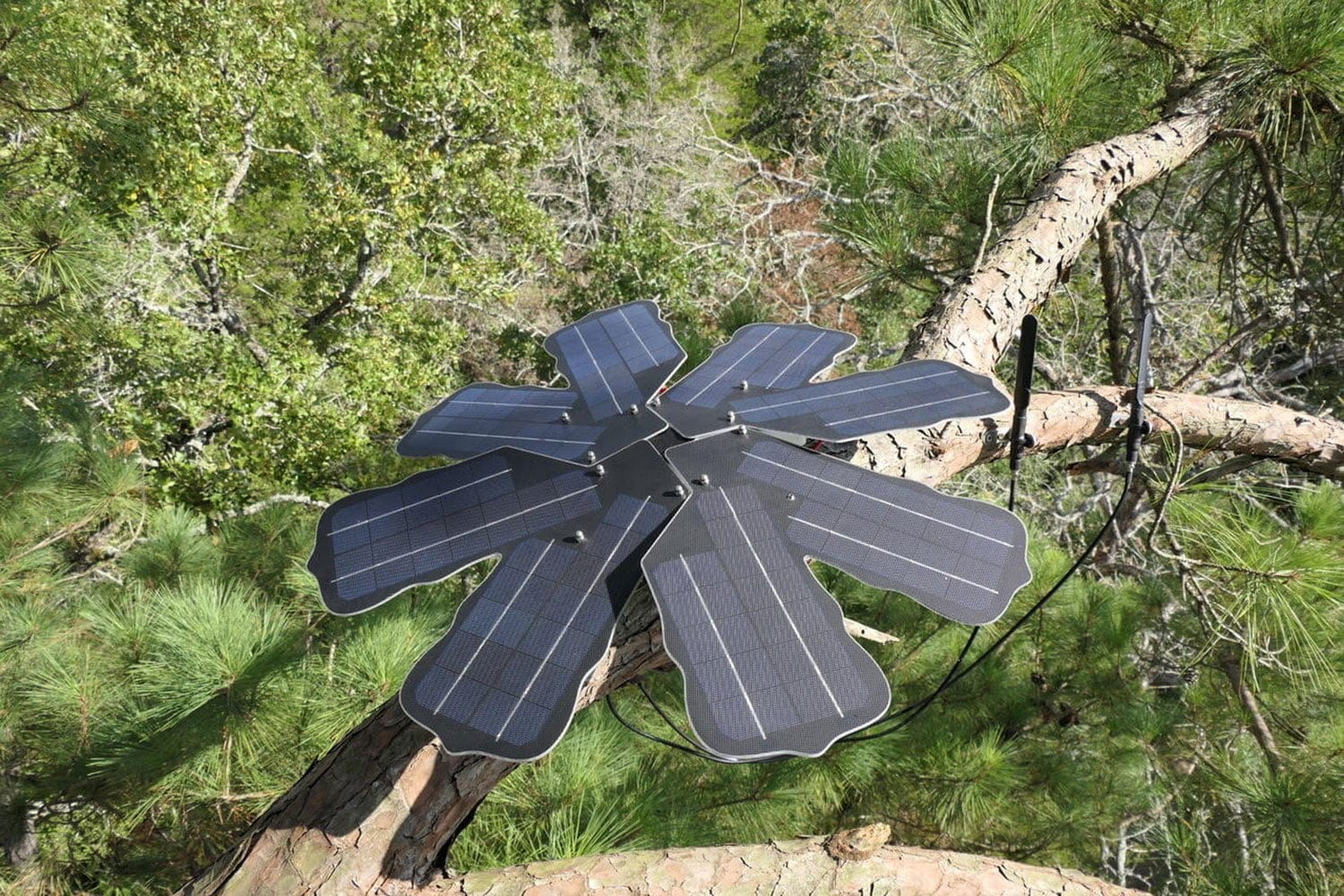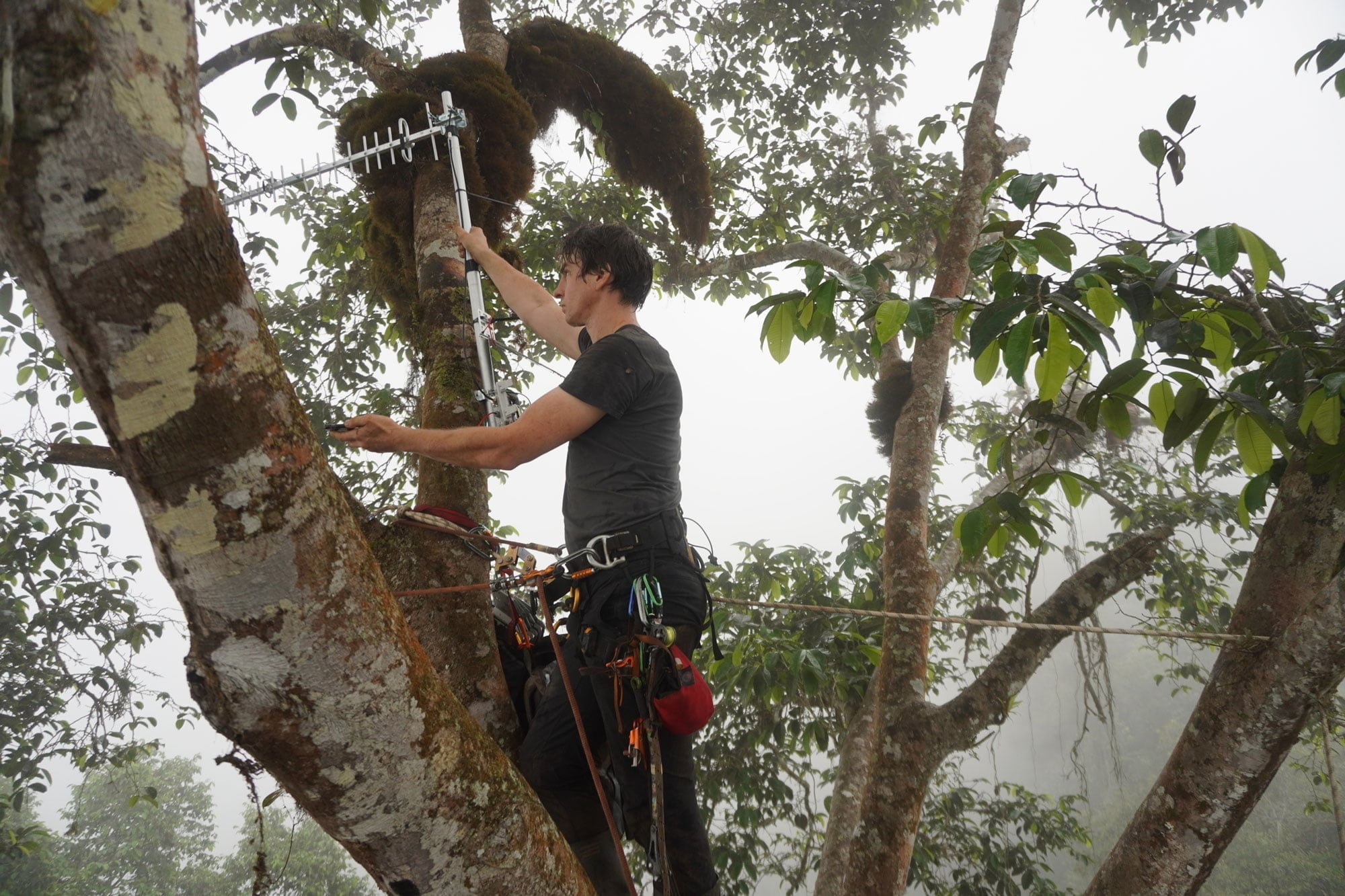Illegal deforestation is a huge problem – but by the time you know it’s happening, it’s usually too late. Now, the trees have ears: microphones in the rainforest canopy are listening out for the sound of chainsaws and vehicles. Can rangers make the most of the headstart?
When forests are cut down illegally, we’re all victims.
Deforestation destroys not only trees, but whole ecosystems that rely on them, harming biodiversity and weakening our defence against climate change. It also contributes to conflict, damaging local economies and even threatening our health, by increasing the chance that species will bring diseases to human settlements.
Unfortunately, illegal timber is big business – worth almost $152 billion a year. It accounts for up to 90% of deforestation in some countries, according to Interpol. And it’s tied up with organised crime, tax evasion, corruption, violence and money laundering.

Spy in the treetops: a microphone, antenna and mini-computer, powered by solar panels. Photo courtesy of RFCx
A major challenge for those protecting the forest is actually finding illegal loggers in time to stop them. Rainforests spanning thousands of hectares are not easy to patrol, and resources to do so are often minimal. In the face of this huge problem, the latest weapon is a very small gadget. But Californian Topher White and his team at Rainforest Connection (RFCx), a nonprofit incorporated in the US, are passionate about the opportunities of technology to support the fight. White first saw this for himself while volunteering at a gibbon reserve in Indonesia back in 2011.
“There was no electricity, no running water, no roads, but there was a pretty good cell phone service”
Topher White
“They were having a pretty big issue with logging on the outskirts of the reserve. They had three full-time guards walking through the forest trying to find the loggers, which is pretty standard. And it was hard to monitor even a pretty modest amount of land.
“There was no electricity, no running water, no roads, but there was a pretty good cell phone service, so I decided to use the sound of the forest to pick up the sound of chainsaws and alert the guards,” he says.
Before starting RFCx, White graduated in physics and pursued a career in science communications, including for the ITER nuclear fusion experiment. This time, he had to build the tech himself. The solution was to rig old mobile phones up to a microphone, attached to mini solar panels to keep the device charged. They record the sound of the forest and stream the data to the cloud, where an AI model detects noises such as chainsaws, vehicles, and gunshots, over an area of up to three square kilometres. A real-time alert is then sent to an app on rangers’ phones, enabling them to intervene.
It took a couple of years to develop the idea into something that would work in the harsh environment of the Sumatran rainforest, but once deployed, the tech caught the sound of some loggers on its second day, boosting White’s confidence.

Fast forward a few years, and RFCx is active in ten countries, predominantly in Latin America – Brazil, Peru, Ecuador, Costa Rica, Belize and Suriname, but also South Africa, the Philippines and Romania. The organisation is working with local and global environmental organisations, such as Conservation International, government rangers, and indigenous peoples on projects to defend land from illegal logging, but also wildlife poaching.
Upcycled cell phones have been exchanged for a bespoke mini-computer consisting of a custom circuit board in a weatherproof enclosure, and equipped with solar panels, a directional antenna and a microphone. The devices are installed in the forest canopy, where there is enough light to power the solar panels.
No easy solutions
White and his team have learned a lot over the years. They started out with the belief that if logging could be located, it could be stopped. “It is true, but in probably less than 10% of cases,” says White. “Simply telling someone where it is happening is not consistently effective in stopping them.” This realisation has been “a bit of a downer”.
Major barriers are safety and resources, he explains. “And when something is dangerous, you have to wonder whether anyone ever feels like they have enough resources,” he says.
Rangers have shown creativity in how they have intercepted loggers, White says. In one recent case in Sumatra, rangers waited at the house of a logger and caught him there. “They didn’t actually go into the forest, which sounds like a bit of a cop-out but it was incredibly effective – he’s never logged again, because they intercepted him at his home,” he says.
However, that case concerned small-scale logging. It can be very different where the logging is industrialised, with multiple trucks, and taking place in indigenous areas where there is a lot of ethnic conflict, such as Brazil, he says. There, the strategy is to intercept the loggers on their way into the forest, not on the way back when their trucks are full of wood.

Sound captured in the rainforest has a variety of applications, says Topher White. Photo courtesy of RFCx
“When they’re well-armed, there’s going to be some kind of a conflict. The faster you get there, the lower the stakes, at least in principle,” he says.
Another key issue the team has become aware of is the lack of enforcement and processes to deal with loggers once they are caught in many countries. “We assumed that they would know what to do with them – we never thought about how intimidating it is to not know,” White admits. RFCx has developed a successful strategy in Peru working with lawyers from the campaign group Sociedad Peruana de Derecho Ambiental (SPDA). When rangers are scrambled to stop logging, the lawyers simultaneously start legal processes, which means that police take the loggers into custody.
RFCx is currently working on a way of keeping track of its achievements. Teams working on the ground do not routinely inform the organisation of all their actions, making it hard to assess progress. “We want to make sure we’re 100% aware of every logging alert that goes out that they follow up on and build that into our overall processes because if you’re not measuring the impact that you’re having, you shouldn’t be talking about it,” White says.

Enforcers apprehend an illegal logger in Narra, Philippines in 2019. Photo: Jes Aznar/Getty Images

Attaching equipment to a tree at the Mashpi Reserve in Ecuador. Photo courtesy of RFCx
Capturing nature’s noise
Stopping deforestation is just one of the applications for RFCx’s technology. A new area of work for the organisation is bioacoustic monitoring – collecting the sounds of birds, animals and insects in the world’s rainforests to create a digital audio library for scientists. The data will help monitor the movements and behaviour of particular species, helping to protect them, or providing information for reintroduction programmes.
The field of bioacoustics has come a long way in the last few years, says Laurel Symes, assistant director of the Center for Conservation Bioacoustics at Cornell University. Having first been used at sea, where other monitoring methods weren’t possible, audio tech is now small enough, powerful enough and cheap enough to make sense on land too. “For $50,000 what we can do now, versus what we could do even 10 years ago has changed a lot,” Symes says.
And automation is set to transform things yet further. “We have a project in Panama where we have 15 recorders that run 24 hours a day for months on end,” says Symes. “We have thousands of hours of data, so it would take hundreds of lifetimes of all 250 people who work with the lab to do any sort of detailed analysis on it. So suddenly you really, really need automated approaches.”
“We’re on the verge of a pretty exciting moment, when you’re able to look into elements of nature that no one was aware existed”
Topher White
RFCx are thinking the same thing. The kind of audio data bank that White has in mind would help scientists to cut down lengthy and expensive processes associated with traditional field trips. The organisation is also designing tools to allow users to query the data in the way that is most relevant to their work, to help them make the discoveries they need.
White says: “If we build the system well, so people can really pull out some amazing insights, we can create a market for bioacoustics that does not exist right now. We’re on the verge of a pretty exciting moment, almost like the invention of the microscope, when you’re able connect AI with large scale bioacoustics in order to look into elements of nature that no one was aware existed.”
WHAT YOU CAN DO
- Donate to RFCx and help protect the planet’s forests.
- Avoid single-use products and packaging. Make sure any forest-derived products you use are recycled or responsibly sourced.
- Reduce the amount of meat and animal products you eat. Livestock farming takes up a lot of land and is a major driver of deforestation.
- Donate to Cornell University’s Center for Conservation Bioacoustics






